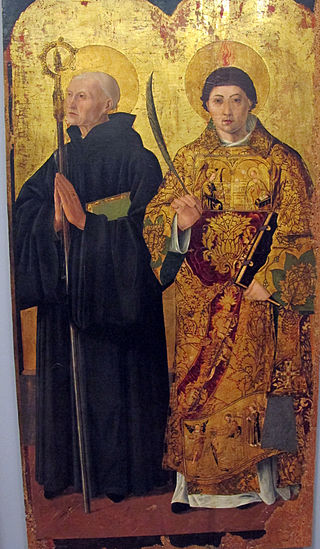
The Tetrarchy was the system instituted by Roman emperor Diocletian in 293 AD to govern the ancient Roman Empire by dividing it between two emperors, the augusti, and their junior colleagues and designated successors, the caesares.
The 300s decade ran from January 1, 300, to December 31, 309.
The 310s decade ran from January 1, 310, to December 31, 319.

Year 313 (CCCXIII) was a common year starting on Thursday of the Julian calendar. At the time, it was known as the Year of the Consulship of Constantinus and Licinianus. The denomination 313 for this year has been used since the early medieval period, when the Anno Domini calendar era became the prevalent method in Europe for naming years. This year is notable for ending of the persecution of Christians in the Roman Empire.
The 290s decade ran from January 1, 290, to December 31, 299.
The 280's decade ran from January 1, 280, to December 31, 289.

Year 306 (CCCVI) was a common year starting on Tuesday of the Julian calendar. At the time, it was known as the Year of the Consulship of Constantius and Valerius. The denomination 306 for this year has been used since the early medieval period, when the Anno Domini calendar era became the prevalent method in Europe for naming years.

Year 307 (CCCVII) was a common year starting on Wednesday of the Julian calendar. At the time, it was known as the Year of the Consulship of Severus and Maximinus. The denomination 307 for this year has been used since the early medieval period, when the Anno Domini calendar era became the prevalent method in Europe for naming years.

Year 311 (CCCXI) was a common year starting on Monday of the Julian calendar. At the time, it was known as the Year of the Consulship of Valerius and Maximinus. The denomination 311 for this year has been used since the early medieval period, when the Anno Domini calendar era became the prevalent method in Europe for naming years.

Year 320 (CCCXX) was a leap year starting on Friday of the Julian calendar.

Year 316 (CCCXVI) was a leap year starting on Sunday of the Julian calendar. At the time, it was known as the Year of the Consulship of Sabinus and Rufinus. The denomination 316 for this year has been used since the early medieval period, when the Anno Domini calendar era became the prevalent method in Europe for naming years.

Flavius Valerius Constantius, also called Constantius I, was a Roman emperor from 305 to 306. He was one of the four original members of the Tetrarchy established by Diocletian, first serving as caesar from 293 to 305 and then ruling as augustus until his death. Constantius was also father of Constantine the Great, the first Christian emperor of Rome. The nickname "Chlorus" was first popularized by Byzantine-era historians and not used during the emperor's lifetime.

Galerius Valerius Maximianus was Roman emperor from 305 to 311. While acting as Caesar under Emperor Diocletian, Galerius obtained victory warring against the Persian Sassanian Empire, defeating Narseh at the battle of Satala in 298 and possibly sacking the Sassanian capital of Ctesiphon in 299. He also campaigned across the Danube against the Carpi, defeating them in 297 and 300. Although he was a staunch opponent of Christianity, Galerius ended the Diocletianic Persecution when he issued the Edict of Toleration in Serdica (Sofia) in 311.

Galerius Valerius Maximinus Daza, born as Daza, was Roman emperor from 310 to 313. He became embroiled in the civil wars of the Tetrarchy between rival claimants for control of the empire, in which he was defeated by Licinius. A committed pagan, he engaged in one of the last persecutions of Christians, before issuing an edict of tolerance granting Christians their freedoms back near his death. Maximinus Daza is the last to be referred as Pharaoh of Egypt.

Marcus Aurelius Valerius Maxentius was a Roman emperor from 306 until his death in 312. Despite ruling in Italy and North Africa, and having the recognition of the Senate in Rome, he was not recognized as a legitimate emperor by his fellow emperors.

The Diocletianic or Great Persecution was the last and most severe persecution of Christians in the Roman Empire. In 303, the emperors Diocletian, Maximian, Galerius, and Constantius issued a series of edicts rescinding Christians' legal rights and demanding that they comply with traditional religious practices. Later edicts targeted the clergy and demanded universal sacrifice, ordering all inhabitants to sacrifice to the Roman gods. The persecution varied in intensity across the empire—weakest in Gaul and Britain, where only the first edict was applied, and strongest in the Eastern provinces. Persecutory laws were nullified by different emperors at different times, but Constantine and Licinius' Edict of Milan in 313 has traditionally marked the end of the persecution.

Saint Sossius or Sosius was Deacon of Misenum, an important naval base of the Roman Empire in the Bay of Naples. He was martyred along with Saint Januarius at Pozzuoli during the Diocletian Persecutions. His feast day is September 23, the date, three days after his death, on which his corpse was translated to Misenum.

The civil wars of the Tetrarchy were a series of conflicts between the co-emperors of the Roman Empire, starting from 306 AD with the usurpation of Maxentius and the defeat of Severus to the defeat of Licinius at the hands of Constantine I in 324 AD.

Saint Januarius in the Amphitheatre at Pozzuoli is a 1635-1637 oil on canvas painting by Artemisia Gentileschi. The work shows the moment that the Christian martyr Januarius and his followers are thrown to a group of wild animals in the amphitheatre in Pozzuoli - however, they lick the saint's feet rather than attacking him and Januarius is unharmed.

The Conference of Carnuntum was a gathering of ancient Roman rulers on 11 November 308, intended to stabilize the power-sharing arrangement known as the Tetrarchy. It was convened by the Eastern augustus (emperor) Galerius in the city of Carnuntum, which at the time was located in the Roman province of Pannonia Prima. A dispute over the title of augustus in the West had been ongoing since the previous year, when consecutive invasions by Severus II and Galerius had failed to recover Italy from the usurpers Maxentius and Maximian. Present at the conference were the retired Diocletian, and his former colleague, Maximian.















